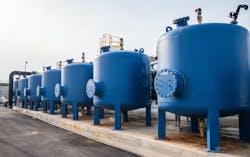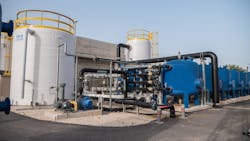About the author:
Cristina Tuser is associate editor for WWD. Tuser can be reached at [email protected]
|
Location: Emek Hayarden, Israel Size: 280 m3/h Equipment: Primary clarifiers, sand filter, lamella clarifier, micronic filter, ultrafilter, reverse osmosis system |
A leader in water technology after solving its own water crisis, Israel launched The Afikey Maim Facility, the country’s first brackish water reverse osmosis (BWRO) reclamation plant. Israel went from being in the middle of its worst drought in 100 years, to maintaining a surplus of water, a feat obtained through a mixture of water conservation and reuse campaigns and desalination plants.
The Afikey Maim Facility reuses water from the southern Jordan River in Israel’s Gilboa area. This river is a mixture of brackish water streams around the Sea of Galilee and wastewater that comes from municipalities and fish ponds. This pollution ultimately limits the ability to use the water for agricultural purposes. Even more, the amount of organic matter and algae in this water makes treatment particularly challenging.
Pretreatment Challenges
The main challenges for the water facility during treatment occur during pretreatment before reverse osmosis (RO).
The facility provides approximately 280 cubic meters per hour (2,000,000 cubic meters per year) of high-quality water for agriculture and industrial use in Israel’s Gilboa area, in addition to approximately 70 m³/h of brine to be used for fish farming ponds.
“The pretreatment has to be very intense in order to overcome all of the suspended solids, organics and algaes that can pretty much fluctuate throughout the year,” said Tomer Efrat, director of business development & product management for IDE Technologies, which oversaw the design, construction and operation of the facility. “During the summer, when it’s hot, you can find many more algae, and during the winter we have rain, so the capacity has to be much higher, so it’s all about stability in this facility.”
The treatment process eradicates total suspended solids (TSS) in the water with coagulation and a lamella clarifier, then goes into ultrafiltration. The water then passes through very fine sand filtration before it goes through a second stage of ultrafiltration. The aim here is to remove some load of the organics, before reaching the RO process thereafter. As a result, the desalination process operates at an 80% recovery rate. The backwash from ultrafiltration is sent back to the reservoir in order to not reduce the recovery by disposing the backwash water.
Redundancies
According to Efrat, the plant is actually divided into two, “in order to allow some redundancy to the plant. We are utilizing everything that we are taking.”
The plant needs to generate brine from the system because the brine from the system is used as seawater for fish farming, as it has higher salinity. Additionally, the water is not pumped directly from the river. Instead, the water must be lifted approximately 100 meters from the river into the reservoir.
Generating water for agriculture is important for the people in the area, since there is a lot of farming and the area is pretty dry. Some of the makeup water is being used for hydro plants as well, which compensates for evaporation losses from the reservoirs with the use of two hydroelectric turbines.
Construction Constraints
There were no major challenges during the construction phase, as IDE Technologies has built some of the largest desalination plants in the world. More than 80% of drinking water in Israel comes from desalinated water. Israel is located on the edge of the desert, so water resources are scarce. Despite this, the country has managed to find more water sources and overcome drought conditions by investing in more water treatment technologies.
“The uniqueness is the type of water that we aim to treat here,” Efrat said. “Not taking the simple water sources like brackish water from wells or water from the sea, where the conditions are pretty much constant, where you know exactly what you’re going to have with the water. It’s the fact that we are doing the reclamation of surface water mixed with wastewater, it’s pretty nasty water to treat.”
As the population in Israel grows, more resources are needed to promote agriculture and industrial activity, and the Afikey Maim Facility aims to contribute to these goals by treating such complex water.
Though this facility is the first of its kind, Israel is no stranger to working against the odds by turning a water crisis into an opportunity, reaching a point where the country can now export water to other countries
in need.

